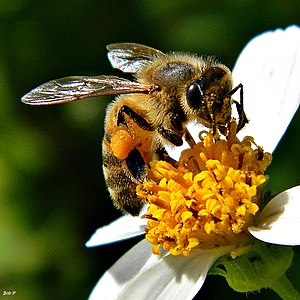Apinae
| Apinae | ||||||||||||
|---|---|---|---|---|---|---|---|---|---|---|---|---|

Honey bee with pollen baskets on the hind leg |
||||||||||||
| Systematics | ||||||||||||
|
||||||||||||
| Scientific name | ||||||||||||
| Apinae | ||||||||||||
| Latreille , 1802 |
Apinae is a subfamily of the Apidae . These include the tribe Apini to which only the genus honeybees belongs, the tribe Bombini which only the rich variety of species of bumblebees comprises tribe of orchid bees (Euglossini) and the tribe the longhorn bees (Eucerini).
The core of the subfamily is the monophyletic group of the corbiculate bees , which are characterized by a morphological feature: all species have so-called corbicula, pollen baskets on the tibia of the hind legs. With these collecting legs, the animals can transport pollen and propolis . The further extent of the subfamily is controversial and differs between different studies, most of which are based on the comparison of homologous DNA sequences (phylogenomics). According to recent studies (from around 2010), these certainly include the South American genera Centris and Epicharis , which in the past were often combined to form a tribe Cenridini (but according to today's view they are not sister groups ). A large clade of species with a kleptoparasitic way of life, which steal the food supplies they have collected for their own offspring from other bee species, is controversial in their affiliation .
Since the extent of the subfamily does not match even in the most recent studies, even by the same working group (status: 2014) and is therefore scientifically controversial, it does not currently make sense to provide a systematic overview.
credentials
- An updating bibliography of the bees of the world
- Sophie Cardinal, Jakub Straka, Bryan N. Danforth (2010): Comprehensive phylogeny of apid bees reveals the evolutionary origins and antiquity of cleptoparasitism. Proceedings of the National Academy of Sciences USA vol. 107 no. 37: 16207-16211. doi : 10.1073 / pnas.1006299107 (open access)
- Bryan N. Danforth, Sophie Cardinal, Christophe Praz, Eduardo AB Almeida, Denis Michez (2013): The Impact of Molecular Data on Our Understanding of Bee Phylogeny and Evolution. Annual Review of Entomology 58: 57-78. doi : 10.1146 / annurev-ento-120811-153633
- Jessica R. Litman, Christophe J. Praz, Bryan N. Danforth, Terry L. Griswold, Sophie Cardinal (2013): Origins, Evolution and diversification of Cleptoparasitic Lineages in long-tongued Bees. Evolution 67: 2982-2998. doi : 10.1111 / evo.12161
- Shannon M Hedtke, Sébastien Patiny Bryan N Danforth (2013): The bee tree of life: a supermatrix approach to apoid phylogeny and biogeography. BMC Evolutionary Biology 2013, 13: 138. doi : 10.1186 / 1471-2148-13-138 (open access)
- Aline C. Martins, Gabriel AR Melo, Susanne S. Renner (2014): The corbiculate bees arose from New World oil-collecting bees: Implications for the origin of pollen baskets. Molecular Phylogenetics and Evolution 80: 88-94. doi : 10.1016 / j.ympev.2014.07.003